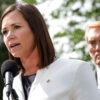The social cost of carbon is a climate economics construct used to quantify the damages associated with carbon dioxide emissions. The Biden administration wants to use the social cost of carbon in public policy to justify its regulatory agenda.
The administration recently invited the public to comment on the Interagency Working Group’s interim technical support document on the social costs of greenhouse gases, including carbon dioxide.
The comment period closed Monday. We submitted our own comments signed by 13 organizations: Competitive Enterprise Institute, Energy & Environment Legal Institute, Center of the American Experiment, CO2 Coalition, Cornwall Alliance for the Stewardship of Creation, Center for Political Renewal, Energy Policy Advocates, National Center for Public Policy Research, Committee for a Constructive Tomorrow, Caesar Rodney Institute, John Locke Foundation, Rio Grande Foundation, and Buckeye Institute.
In a nutshell, we developed a multilayered case against the Biden administration using the social cost of carbon analysis as a basis, framework, or tool for guiding or informing federal agency regulatory, permitting, or procurement decisions. Specifically, we argue that the social cost of carbon analysis depends too much on non-validated assumptions and inputs to be fit for policymaking.
The Interagency Working Group’s 2021 interim technical support document utilizes questionable, cherry-picked assumptions and inputs to support the climate crisis narrative and promote climate policies whose costs would hugely exceed the undetectably small hypothetical benefits.
Our comments are as follows:
Section 1 provides an overview of social cost of carbon analysis basics. It explains why the integrated assessment models used to estimate social cost of carbon values are not fit to guide policymaking. We also outline specific flaws in the Interagency Working Group’s methodology.
The Interagency Working Group uses outdated climate sensitivity assumptions, below-market discount rates, an analysis period extending far beyond the limits of informed speculation, and implausible emission baselines. Two of its integrated assessment models unscientifically depreciate carbon dioxide fertilization benefits, and one unreasonably depreciates human adaptative capabilities.
Section 2 discusses the Interagency Working Group’s reliance on climate sensitivity estimates from models that overestimate observed tropical tropospheric warming over the past 40 years.
We caution that the Interagency Working Group’s social cost of carbon estimates will become even more unrealistic if integrated assessment models’ sensitivity assumptions come from the Coupled Model Intercomparison Project. These models will be used in the forthcoming Sixth Assessment Report of the Intergovernmental Panel on Climate Change.
The social cost of carbon is too speculative and assumption-driven for any government to adopt its official estimates. However, if the Interagency Working Group insists on doing so, it should use only the climate sensitivity estimates similar to those of the Russian Institute of Numerical Mathematics suite of general circulation models—the only models to accurately track observed tropical tropospheric warming since 1979.
Section 3 sets the stage for the next sections. It shows in detail how integrated assessment model assumptions and inputs can easily be manipulated for political purposes. Sections 3 to 8 draw upon Kevin Dayaratna’s 2020 congressional testimony.
Section 4 shows how discount rates affect social cost of carbon estimates. We make a case for using a 7% discount rate, which would allow the public to compare the productivity of climate policy investments to market-driven investments. Using a 7% rate would dramatically reduce the Interagency Working Group’s social cost of carbon estimates.
If the Interagency Working Group continues to produce social cost of carbon estimates, it should include a 7% discount rate. It should not use below-market (1% to 2%) discount rates, which only serve propaganda purposes such as making fossil fuels look unaffordable no matter how cheap, and renewables look like a bargain at any price.
Section 5 discusses how the time horizon affects social cost of carbon estimates. The Interagency Working Group estimates cumulative climate damages to the year 2300—beyond the limits of informed speculation. Even if the Interagency Working Group gets climate sensitivity right, it is in no position to make official pronouncements about the economic and technological evolution of the 22nd and 23rd centuries.
If the Interagency Working Group continues to produce social cost of carbon estimates, it should limit the analytic horizon to 2150, which could reduce social cost of carbon estimates by more than 25%.
Section 6 explains that the Interagency Working Group relies on an outmoded climate sensitivity probability distribution that inflates social cost of carbon estimates. If the Interagency Working Group continues to produce social cost of carbon estimates, it should use sensitivity estimates from recent empirically constrained studies. This could dramatically reduce the Interagency Working Group’s social cost of carbon estimates.
Section 7 shows that running the Climate Framework for Uncertainty, Negotiation, and Distribution model with updated climate sensitivity empirical information produces significant probabilities of negative social cost of carbon estimates through at least the mid-21st century.
That means there is a significant probability that the agricultural benefits of carbon dioxide emissions will outweigh any climate change-related damages beyond the next 30 years. If the Interagency Working Group continues to produce social cost of carbon estimates, it should clearly present the probabilities of negative social cost of carbon values.
Section 8 documents the immense agricultural benefits of carbon dioxide fertilization. Dynamic Integrated Climate and Economy and Policy Analysis of the Greenhouse Effect—two of the Interagency Working Group’s three integrated assessment models—effectively assign zero dollars to those benefits.
The Climate Framework for Uncertainty, Negotiation, and Distribution model estimates carbon dioxide fertilization benefits based on studies from the 1990s. If the Interagency Working Group continues to produce social cost of carbon estimates, it should not use models that ignore carbon dioxide fertilization benefits. It should utilize the best available science to estimate such benefits.
Section 9 provides an assessment of human-adaptive capabilities based on various long-term trends, including the 99% global drop in the average person’s risk of dying from extreme weather events over the past 100 years. If the Interagency Working Group continues to produce social cost of carbon estimates, it should eschew models that assume adaptation is futile beyond 2 degrees Celsius of warming and 10 inches of rising sea levels.
Section 10 discusses the Interagency Working Group’s implausibility of using baseline emission scenarios to estimate the incremental impact of an additional ton of carbon dioxide emissions.
Four of the Interagency Working Group’s five baseline emission scenarios implausibly assume that, absent specific climate policies, the world returns to a coal-based energy system, not just for the remainder of the 21st century, but through the entire analysis period ending in 2300. This assumption dramatically inflates social cost of carbon estimates.
Replacing it with more realistic emission baselines would just as dramatically reduce those estimates. If the Interagency Working Group continues to produce social cost of carbon estimates, it should replace its outmoded emission baselines with new baselines reflecting recent energy market and emission trends.
As we have discussed many times before, the social cost of carbon is the most useless number you have never heard of. Do not be fooled by the Washington establishment’s use of sophisticated statistical models to make itself look credible.
The social cost of carbon is highly susceptible to user manipulation and, as our research has indicated, it can predict essentially anything due to climate change, ranging from economic hardship and global disasters to continued prosperity and lasting long-term benefits. We look forward to seeing how the administration uses these comments as it attempts to revise the social cost of carbon.
Our comments are available here.
Have an opinion about this article? To sound off, please email letters@DailySignal.com and we’ll consider publishing your edited remarks in our regular “We Hear You” feature. Remember to include the URL or headline of the article plus your name and town and/or state.

























